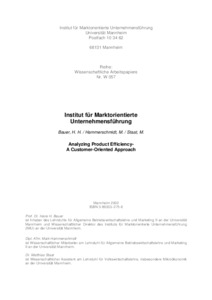|
Analyzing Product Efficiency : A Customer-Oriented Approach
Bauer, Hans H.
;
Hammerschmidt, Maik
;
Staat, Matthias
![[img]](https://madoc.bib.uni-mannheim.de/7930/1.hassmallThumbnailVersion/W057_Analyzing%20Product%20Effiency%2Cpdf.pdf)  Vorschau |
|
PDF
W057_Analyzing Product Effiency,pdf.pdf
- Veröffentlichte Version
Download (222kB)
|
|
URL:
|
https://ub-madoc.bib.uni-mannheim.de/7930
|
|
URN:
|
urn:nbn:de:bsz:180-madoc-79301
|
|
Dokumenttyp:
|
Arbeitspapier
|
|
Erscheinungsjahr:
|
2002
|
|
Titel einer Zeitschrift oder einer Reihe:
|
Reihe: Wissenschaftliche Arbeitspapiere / Institut für Marktorientierte Unternehmensführung
|
|
Band/Volume:
|
W057
|
|
Ort der Veröffentlichung:
|
Mannheim
|
|
Verlag:
|
Inst. für Marktorientierte Unternehmensführung, Univ. Mannheim
|
|
ISBN:
|
3-89333-275-8 , 978-3-89333-275-5
|
|
Sprache der Veröffentlichung:
|
Englisch
|
|
Einrichtung:
|
Fakultät für Betriebswirtschaftslehre > ABWL u. Marketing II (Bauer 1993-, Em)
|
|
Fachgebiet:
|
330 Wirtschaft
|
|
Abstract:
|
The purpose of this study is to provide a broader, economic perspective on customer value management. By developing an efficiency-based concept of customer value we aim at contributing to the presently underrepresented research field of marketing economics. The customer value concept is utilized to assess product performance and eventually to determine the competitive market structure and the product-market boundaries. Our analytical approach to product-market structuring based on customer value is developed within a microeconomic framework. We measure customer value as the product efficiency viewed from the customer’s perspective, i.e., as a ratio of outputs (e.g., resale value, reliability, safety, comfort) that customers obtain from a product relative to inputs (price, running costs) that customers have to deliver in exchange. The efficiency value derived can be understood as the return on the customer’s investment. Products offering a maximum customer value relative to all other alternatives in the market are characterized as efficient. Different efficient products may create value in different ways using different strategies (output-input-combinations). Each efficient product can be viewed as a benchmark for a distinct sub-market. Jointly, these products form the efficient frontier, which serves as a reference function for the inefficient products. Thus, we define customer value of alternative products as a relative concept. Market partitioning is achieved endogenously by clustering products in one segment that are benchmarked by the same efficient peer(s). This ensures that only products with a similar output-input structure are partitioned into the same sub-market. As a result, a sub-market consists of highly substitutable products. In addition, value-creating strategies (i.e., indications of how to vary inputs and outputs) to improve product performance in order to offer maximum customer value are provided.
|
 | Dieser Eintrag ist Teil der Universitätsbibliographie. |
 | Das Dokument wird vom Publikationsserver der Universitätsbibliothek Mannheim bereitgestellt. |
 Suche Autoren in Suche Autoren in
Sie haben einen Fehler gefunden? Teilen Sie uns Ihren Korrekturwunsch bitte hier mit: E-Mail
Actions (login required)
 |
Eintrag anzeigen |
|
|



 Suche Autoren in
Suche Autoren in